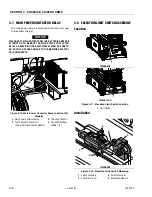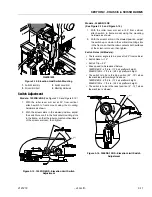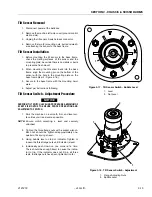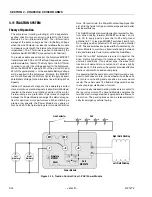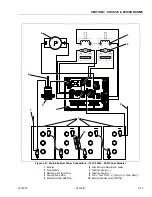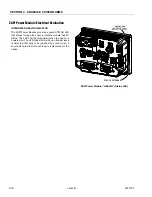
SECTION 3 - CHASSIS & SCISSOR ARMS
3-6
– JLG Lift –
3121273
4. If this problem does not clear after the battery volt-
age is confirmed to be higher than 1.0V per cell and
all connections are good, return the charger for ser-
vice.
[3 Flashes] - Charge Time-out
Indicates the battery failed to charge within the allowed
time. This could occur if the battery is of larger capacity
than the algorithm is intended for. In unusual cases it
could mean charger output is reduced due to high ambi-
ent temperature. It can also occur if the battery is dam-
aged, old, or in poor condition.
1. Check the battery for damage such as shorted cells
and insufficient water. Try the charger on a good bat-
tery.
2. If the same fault occurs on a good battery, check the
connections on the battery and connection to AC,
and the AC voltage itself.
3. Confirm that the nominal battery pack voltage is the
same as the battery charger voltage.
4. This fault must be cleared manually by unplugging
the AC, waiting 30 seconds and reconnecting the
AC power.
5. If a charger displays this fault on a battery pack, and
the pack is of questionable status, reset the charger
by disconnecting AC for 30 seconds, and then
reconnect the AC to start a new charge cycle. After a
few charge cycles, this problem could stop occur-
ring as the pack "recovers."
[4 Flashes] - Check Battery
This fault indicates the battery pack could not be trickle
charged up to the minimum level required for the normal
charge cycle to be started.
1. Check that none of the battery pack connections
between modules are reversed or incorrectly con-
nected.
2. Check that one or more cells in the battery are not
shorted.
3. Confirm that the nominal battery pack voltage is the
same as the battery charger voltage.
4. Try the charger on a good battery.
5. If this fault occurs, the battery is likely in poor condi-
tion. Try to recover the pack with a charger that can
charge the individual cells - such as an automotive
charger. Be sure to set this charger to the appropri-
ate voltage - 6V per 6V battery, 12V per 12V string/
battery.
[5 Flashes] - Over Temperature
This fault indicates the charger has become too hot during
operation. Though not damaging to the charger, charge
time will be extended significantly.
1. This fault indication will not clear automatically, but
the charger will restart charging automatically when
the temperature drops. The fault indication must be
cleared manually by unplugging the AC, waiting 30
seconds and reconnecting the AC power.
2. If possible, move the machine to a cooler location.
3. Confirm that dirt or mud is not blocking the cooling
fins of the charger. Clean the charger. Rinse the
charger with a low pressure hose if required. Do no
use high pressure. Do not us a pressure washer.
[6 Flashes] - Over Load/Over Temperature
This fault indicates that the batteries will not accept charge
current, or an internal fault has been detected in the char-
ger. This fault will nearly always be set within the first 30
seconds of operation. If it occurs after the charger has
started charging normally, complete the following steps.
1. Try to clear the fault by unplugging the AC, waiting
30 seconds and reconnecting the ac power.
2. Check all battery connections. Look for a high resis-
tance connection.The most likely reason for this fault
is a fault in the battery such as a bad battery con-
nection, an open cell, or insufficient water.
3. This fault will occur if an internal fuse inside the char-
ger blows. If the green wire is shorted to ground
even momentarily, this fuse will blow. To check the
fuse, measure with an ohmmeter between the green
and red wires with the AC disconnected. If a short
circuit is not measured, the fuse has blown. Return
unit to a service depot to have this fuse replaced.
4. If this fault occurs after battery charging has started,
confirm that AC power was not interrupted and that
all battery connections are good.
5. If all battery connections are good, an internal fault
has been detected and the charger must be brought
to a qualified service depot.



















